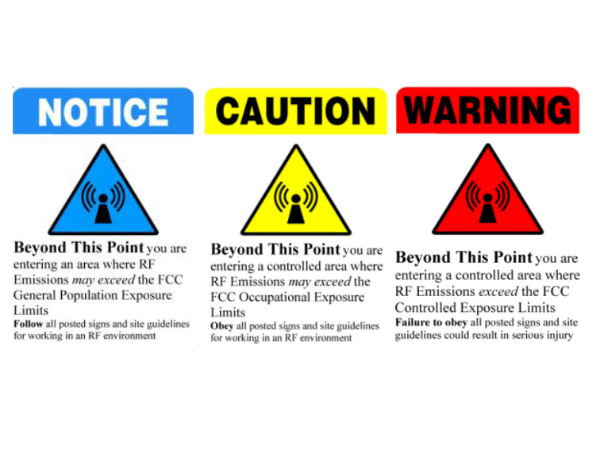
Understanding Radio Frequency (RF) Safety for Elevator Mechanics
In the elevator industry, radio frequency (RF) is an invisible hazard that poses significant risk to workers. While some workplace dangers develop over time, RF exposure can cause instant injuries, including electrical shock, burns, sterility, and cataracts. This type of radiation functions similar to that of a microwave, heating body tissue when exposure levels reach a certain threshold.
The severity of injury depends on both the worker’s proximity to the transmitter and the intensity of the radiation. RF is undetectable to human senses, making it essential to recognize the warning signs and understand how to minimize risk when working close to RF-emitting equipment.
Elevator Mechanics, particularly those accessing rooftop machine rooms, are at increased risk of RF exposure. With wireless communication infrastructure expanding rapidly, more buildings are equipped with RF radiation-emitting transmitters and antennas. By understanding the sources of RF exposure, the protective measures available, and the regulations from the Occupational Safety and Health Administration (OSHA) and the Federal Communications Commission (FCC), Mechanics can ensure they’re working as safely as possible.
Sources of RF Exposure
Numerous wireless communication technologies, such as cell towers, radio and TV transmitters, antennas, and satellite communications use RF radiation. The RF spectrum ranges from 3 kHz to 300 GHz, depending on the types of communication. The closer you get to an active source of RF, the greater the potential exposure.
Elevator Mechanics often encounter RF hazards when working in high-rise buildings with rooftop antennas. Though not always visible from a distance, these antennas can cause exposure, even when the equipment is not directly in sight. That’s why it is critical to make yourself aware of any posted signage in the working environment.
FCC and OSHA Standards for RF Safety
As mentioned, both the FCC and OSHA have set limits on RF exposure in an attempt to protect workers. OSHA standard 1926.54(l) states that employees should not be exposed to microwave power densities exceeding 10 milliwatts per square centimeter (10 mW/cm²). The FCC, on the other hand, is the primary regulatory body responsible for establishing exposure limits, designating two categories of RF exposure:
- Controlled/Occupational Exposure: This applies to workers who are fully aware of their exposure and have been trained to limit and control their contact with RF radiation.
- Uncontrolled/General Population Exposure: This category applies to all other individuals, including workers who are unaware of RF exposure risks and do not have the ability to control their exposure.
Elevator Mechanics tend to fall under uncontrolled/general population exposure, meaning that they are responsible for taking proactive steps to assess job sites, identify RF hazards, and implement appropriate safety measures.
Rules for Regulated RF Areas
The FCC also requires companies that operate RF transmitters to post signage and restrict access to high-exposure areas. There are three designated RF exposure zones, each marked by a different colored sign.
Green Zone (Blue “Notice” Sign)
Green zones have RF levels that may exceed the general population limits but remain below occupational exposure limits. Radiation exposure here is less than 20% of the FCC’s maximum limit. Workers should take precautions, and these zones are generally safe for brief work periods.
Yellow Zone (Yellow “Caution” Sign)
In yellow zones, RF levels range between 20% and 100% of the FCC’s maximum exposure limit. Both general population and occupational exposure limits may be exceeded. Workers are obliged to notify their superior before proceeding and must always maintain a safe distance of three feet from these areas.
Red Zone (Red “Warning” Sign)
Red zones see RF exposure rise substantially, exceeding 100% of the FCC’s maximum exposure limits. Workers must not enter a red zone unless proper safety procedures, including shutting down transmitters or wearing RF protective gear, have been followed. Supervisors must be notified immediately if work near or in a red zone is required.
Best Practices for RF Safety
To mitigate the risks associated with RF exposure, Elevator Mechanics should always read and follow posted signage before entering any rooftop area where RF radiation may be present. RF-restricted areas are marked as such for a reason, and workers must never cross fences or barriers. Limiting time spent in RF fields is also imperative, as prolonged exposure increases the risk. Mechanics should plan efficiently to ensure they can reduce any unnecessary exposure and minimize time spent near RF-emitting devices. Regularly reviewing company RF safety procedures also helps ensure a safer work environment for all.
Stay Alert, Stay Safe
RF radiation is a real and immediate hazard for Elevator Mechanics. Anyone working in buildings with wireless communication equipment must ensure they’re aware of the steps involved in working safely in these environments. Unlike other workplace hazards that develop over time, RF exposure can cause instant injury. By understanding FCC and OSHA regulations, recognizing RF exposure zones, and following best safety practices, Elevator Mechanics can protect themselves from the dangers of RF radiation. As wireless infrastructure continues to expand, RF safety awareness will remain essential. Remain vigilant, respect posted warnings, and prioritize your safety.
